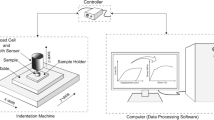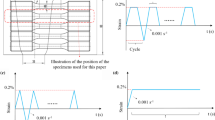Abstract
The uniform elongation, which is the key factor to the constitutive behavior, is generally calculated by the Considère criterion, i.e., the uniform elongation equates the work-hardening exponent. However, it is found in this study that the widely used Considère criterion is not applicable to metals when the materials are subjected to the maximum load, as the first derivative of the fitted constitutive behavior is not zero which is the basic assumption in Considère criterion. To acquire the whole constitutive behaviors, an accurate and universal method is proposed, based on the work-hardening exponent and yield strength, to calculate the uniform elongation beforehand. With the yield strength obtained via the DIC data, and the work-hardening exponent determined by fitted Ramberg-Osgood model, the uniform elongation can be calculated by the new proposed method. The accuracy of the new method is validated by the conventional load method, indicating that the proposed method is applicable and feasible. With the uniform elongation calculated by the proposed method, the whole constitutive behavior of API 5 L X90 welds can be easily obtained.













Similar content being viewed by others
References
Fagerholt E, Østby E, Børvik T, Hoppersta OS (2012) Investigation of fracture in small-scale SENT tests of a welded X80 pipeline steel using digital image correlation with node splitting. Eng Fract Mech 96:276–93
Østby E, Thaulow C, Nyhusa B (2007) A new approach to ductile tearing assessment of pipelines under large-scale yielding. Int Int J Pres Ves Pip 84:337–48
Berg E, Østby E, Thaulow C, Skallerud B (2008) Ultimate fracture capacity of pressurised pipes with defects – Comparisons of large scale testing and numerical simulations. Eng Fract Mech 75:2352–66
Lockwood WD, Tomaz B, Reynolds AP (2002) Mechanical response of friction stir welded AA2024: experiment and modeling. Mater Sci Eng A 323:348–53
Sato YS, Yamanoi H, Kokawaa H, Furuhara T (2007) Microstructural evolution of ultrahigh carbon steel during friction stir welding. Scripta Mater 27:557–60
Molak RM, Paradowski K, Brynk T, Ciupinski L, Pakiela Z, Kurzydlowski KJ (2009) Measurement of mechanical properties in a 316 L stainless steel welded joint. Int J Press Vessels Pip 86:43–7
Bleck W, Reisgen U, Mokrov O, Rossiter E, Rieger T (2010) Methodology for thermomechanical simulation and validation of mechanical weld-seam properties. Adv Eng Mater 12:147–52
Lemmen HJK, Alderliesten RC, Benedictus R, Hofstede JCJ, Rodi R (2008) The power of digital image correlation for detailed elastic–plastic strain measurements. In: WSEAS international conference on engineering mechanics, structures, engineering geology. Crate Island, Greece
Xavier J, Avril S, Pierron F, Morais J (2009) Variation of transverse and shear stiffness properties of wood in a tree. Compos Part A 40:1953–60
Pereira J, Xaier J, Morais J, Losada J (2014) Assessing wood quality by spatial variation of elastic properties within the stem: case study of Pinus pinaster in the transverse plane. Can J For Res 44(2):107–17
Xavier J, Belini U, Pierron F, Morais J, Lousada J, Tomazello M (2013) Characterisation of the bending stiffness components of MDF panels from full-field slope measurements. Wood Sci Technol 47:423–41
Le Magoroua L, Bosa F, Rougerb F (2002) Identification of constitutive laws for wood-based panels by means of an inverse method. Compos Sci Technol 62:591–96
Xavier J, Avril S, Pierron F, Morais J (2007) Novel experimental approach for longitudinal-radial stiffness characterisation for clear wood by a single test. Holzforschung 61(5):573–81
Majano-Majano A, Fernandez-Cabo JL, Hoheisel S, Klein M (2011) A test method for characterizing clear wood using a single Specimen. Exp Mech 52:1079–96
Devivier C, Pierron F, Wisnom MR (2013) Impact damage detection in composite plates using deflectometry and the virtual fields method. Compos Part A 48:201–18
Lockwood WD, Reynolds AP (2003) Simulation of the global response of a friction stir weld using local constitutive behavior. Mater Sci Eng A 339:35–42
Brown R, Tang W, Reynolds AP (2009) Multi-pass friction stir welding in alloy 7050-T7451: effects on weld response variables and on weld properties. Mater Sci Eng A 513–514:115–21
Scintilla LD, Tricarico L, Brandizzi M, Satriano AA (2010) Nd:YAG laser weldability and mechanical properties of AZ31 magnesium alloy butt joints. J Mater Process Technol 210:2206–14
Boyce B, Reu P, Robino C (2006) The constitutive behavior of laser welds in 304 L stainless steel determined by digital image correlation. Metall Mater Trans A 37:2481–92
Sutton MA, Yan JH, Avril S, Pierron F, Adeeb SM (2008) Identification of heterogeneous constitutive parameters in a welded specimen: uniform stress and virtual fields methods for material property estimation. Exp Mech 48:451–64
Genevois C, Deschamps A, Vacher P (2006) Comparative study on local and global mechanical properties of 2024 T351, 2024 T6 and 5251 O friction stir welds. Mater Sci Eng A 415:162–70
Leitao C, Leal RM, Rodrigues DM, Loureiro A, Vilaça P (2009) Mechanical behaviour of similar and dissimilar AA5182-H111 and AA6016-T4 thin friction stir welds. Mater Des 30:101–8
Zhang ZL, Hauge M, Thaulow C, Ødegard J (2002) A notched cross weld tensile testing method for determining true stress–strain curves for weldments. Eng Mech Fract 69:353–366
Zhang ZL, Hauge M, Odegard J, Thaulow C (1999) Determining material true stress strain curve from tensile specimens with rectangular cross-section. Int J Solids Struct 36:3497–3516
ISO 6892-1-2009 (2009) Metallic materials -tensile testing - part 1: method of test at room temperature. ISO, Switzerland
GB/T 228–2002 (2002) Metallic Materials - Tensile Testing at Ambient Temperature, State Quality Supervision and Inspection & Quarantine Bureau of P.R.C, China
Chu TC, Ranson WF, Sutton MA (1985) Applications of digital-image-correlation techniques to experimental mechanics. Exp Mech 25(3):232–44
Sutton MA, Orteu JJ, Schreier HW (2009) Image correlation for shape motion and deformation measurements. Springer
William DC (2001) Fundamentals of Materials Science and Engineering-An introduction. Fifth Edition
Anderson TL (2005) Fracture mechanics: fundaments and applications. 3rd ed. CRC Press
Dowling NE (1999) Mechanical behavior of materials: engineering methods for deformation, fracture and Fatigue, 2nd edn. Prentice Hall, New Jersey
Paredes M, Ruggieri C (2015) Engineering approach for circumferential flaws in girth weld pipes subjected to bending load. Int J Pres Ves Pip 125:49–65
Sarzosa DFB, Souza RF, Ruggieri C (2015) J–CTOD relations in clamped SE(T) fracture specimens including 3-D stationary and growth analysis. Eng Fract Mech online
API standard 1104 (2013) Welding of pipelines and related facilities. API, USA
Acknowledgments
The authors gratefully acknowledge the sponsorship of this work by the Specialized Research Fund for the Doctoral Program of Higher Education of China (Grant No. 20100007110006).
Author information
Authors and Affiliations
Corresponding author
Rights and permissions
About this article
Cite this article
Kong, L., Shuai, J., Zhou, X. et al. A Universal Method for Acquiring the Constitutive Behaviors of API -5 L X90 Welds. Exp Mech 56, 165–176 (2016). https://doi.org/10.1007/s11340-015-0088-z
Received:
Accepted:
Published:
Issue Date:
DOI: https://doi.org/10.1007/s11340-015-0088-z




